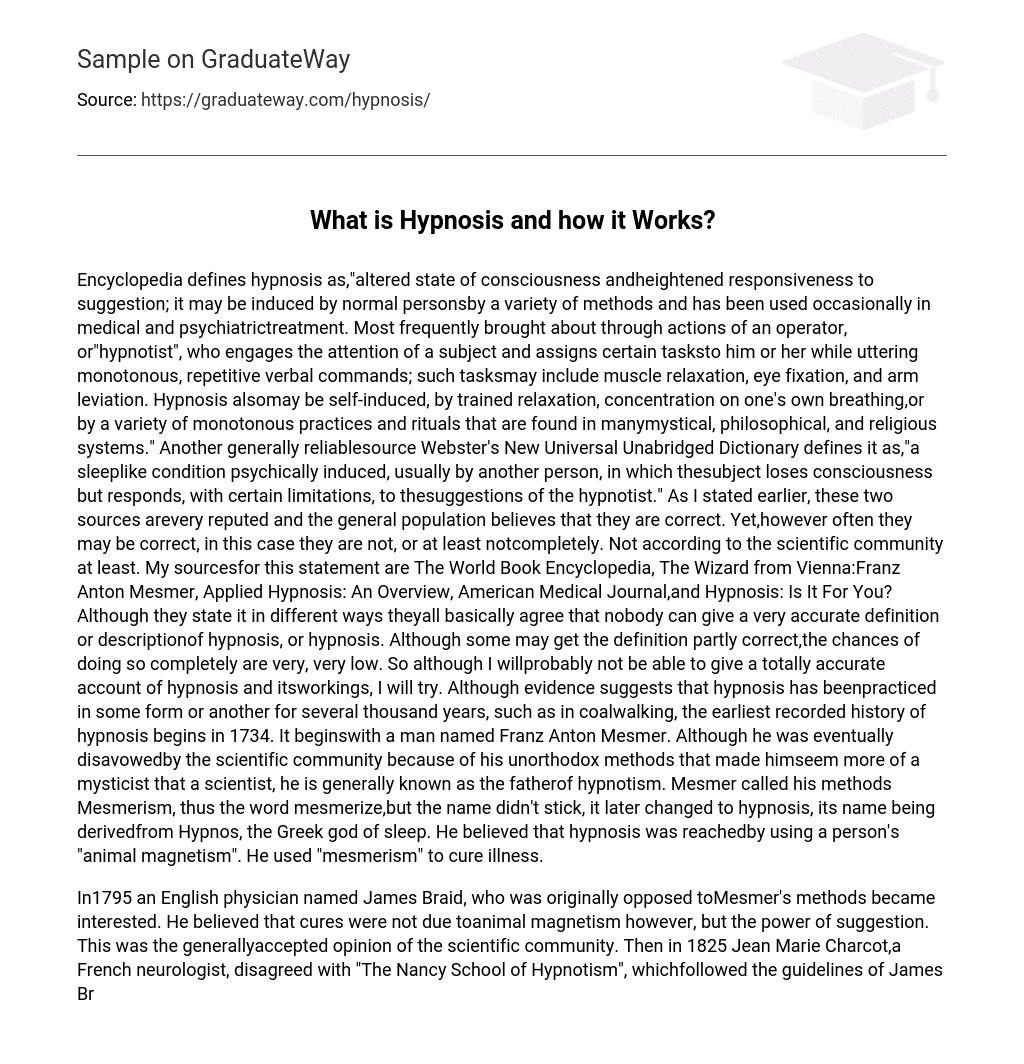Encyclopedia defines hypnosis as,”altered state of consciousness andheightened responsiveness to suggestion; it may be induced by normal personsby a variety of methods and has been used occasionally in medical and psychiatrictreatment. Most frequently brought about through actions of an operator, or”hypnotist”, who engages the attention of a subject and assigns certain tasksto him or her while uttering monotonous, repetitive verbal commands; such tasksmay include muscle relaxation, eye fixation, and arm leviation. Hypnosis alsomay be self-induced, by trained relaxation, concentration on one’s own breathing,or by a variety of monotonous practices and rituals that are found in manymystical, philosophical, and religious systems.” Another generally reliablesource Webster’s New Universal Unabridged Dictionary defines it as,”a sleeplike condition psychically induced, usually by another person, in which thesubject loses consciousness but responds, with certain limitations, to thesuggestions of the hypnotist.” As I stated earlier, these two sources arevery reputed and the general population believes that they are correct. Yet,however often they may be correct, in this case they are not, or at least notcompletely. Not according to the scientific community at least. My sourcesfor this statement are The World Book Encyclopedia, The Wizard from Vienna:Franz Anton Mesmer, Applied Hypnosis: An Overview, American Medical Journal,and Hypnosis: Is It For You? Although they state it in different ways theyall basically agree that nobody can give a very accurate definition or descriptionof hypnosis, or hypnosis. Although some may get the definition partly correct,the chances of doing so completely are very, very low. So although I willprobably not be able to give a totally accurate account of hypnosis and itsworkings, I will try. Although evidence suggests that hypnosis has beenpracticed in some form or another for several thousand years, such as in coalwalking, the earliest recorded history of hypnosis begins in 1734. It beginswith a man named Franz Anton Mesmer. Although he was eventually disavowedby the scientific community because of his unorthodox methods that made himseem more of a mysticist that a scientist, he is generally known as the fatherof hypnotism. Mesmer called his methods Mesmerism, thus the word mesmerize,but the name didn’t stick, it later changed to hypnosis, its name being derivedfrom Hypnos, the Greek god of sleep. He believed that hypnosis was reachedby using a person’s “animal magnetism”. He used “mesmerism” to cure illness.
In1795 an English physician named James Braid, who was originally opposed toMesmer’s methods became interested. He believed that cures were not due toanimal magnetism however, but the power of suggestion. This was the generallyaccepted opinion of the scientific community. Then in 1825 Jean Marie Charcot,a French neurologist, disagreed with “The Nancy School of Hypnotism”, whichfollowed the guidelines of James Braid’s ideas.Charcot believed that hypnosiswas simply a “manifestation of hysteria”. He revived Mesmer’s theory of animalmagnetism and identified the three stages of the trance; lethargy, catalepsy,and somnambulism.
Ivan Petrovich Pavlov (1849-1936) was not a scientist whoworked with hypnosis. Although he had nothing to do with the hypnotic developmentitself, his Stimulus Response Theory is a cornerstone linking and anchoringbehaviors, particularly NLP (Neuro-Linguistic Programming).
Emily Coue (1857-1926)a physician, formulated the Laws of Suggestion which are greatly used in thehypnotic community. Her first law is The Law of Concentrated Attention: “Wheneverattention is concentrated on an idea over and over again, it spontaneouslytends to realize itself”. The second law is- The Law of Reverse Action: “Theharder one tries to do something, the less chance one has of success.” Finally,the last law is The Law of Dominant Effect: “A stronger emotion tends to replacea weaker one.”Milton Erickson (1932-1974), a psychologist and psychiatristpioneered the art of indirect suggestion in hypnosis. He is considered thefather of modern hypnosis. His methods bypassed the conscious mind throughthe use of both verbal and nonverbal pacing techniques including metaphor,confusion, and many others. He was definitely a major influence in contemporaryhypnotherapy’s acceptance by the American Medical Association.
There aremany misconceptions about hypnosis that are totally without basis. Such as,”Hypnotized persons will tell secrets or will always tell the truth.” Thetruth is, hypnosis will not cause a person to tell information the do not wantto tell and a person under hypnosis can purposefully lie or remember in a distortedfashion. Another myth about hypnotism is, “Hypnosis won’t work on highly intelligentpeople.” In reality innate characteristics such as intelligence do not atall effect hypnotism. Any person however can resist being hypnotized eitheractively or passively, if they desire. I believe that hypnotism would be amore commonly used method in medicine if it were not for all the myths goingaround about hypnotism. They are probably the result of the very limited knowledgeof exactly how hypnosis works.
Hypnosis has been used to treat a varietyof physiological and behavioral problems. It can alleviate back pain and painthat comes from burns or cancer. It is controversial as to whether this actuallyworks or not, but it is believed that it can be used to insure normal and safechildbirth. Hypnosis sometimes is employed to treat physical problems witha psychological component, such as a circulatory disease known as Raynaud’sSyndrome. It has also been used to initiate behavioral changes, for examplecigarette smoking, overeating, insomnia, and the overcoming of phobia’s. Althoughhypnotism has shown its uses as a fairly valuable medical tool, in this modern”technological age” there are very few physicians who use it.
The major useof hypnotism in modern days, is entertainment. Performed as a sort of “MagicShow” it is used to cause some people to laugh, and some people to be amazed.
Hypnotism has come a long way since 1734 and who knows what future developmentswill be made in this field? It may become a commonly used medical tool, orit may come to be thought of as a completely useless “magic trick”. Words/ Pages : 972 / 24





